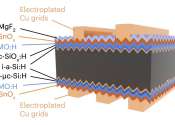An affordable and scalable strategy to fabricate efficient silicon heterojunction solar cells
Silicon heterojunction (SHJ), solar cells based on a heterojunction between semiconductors with different band gaps, are among the most promising photovoltaic technologies. So far, these cells have exhibited remarkable power ...









